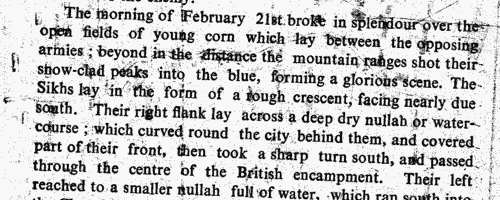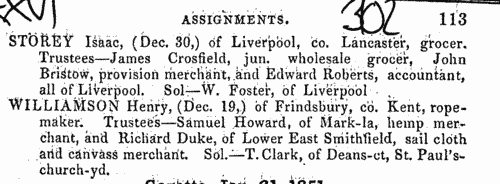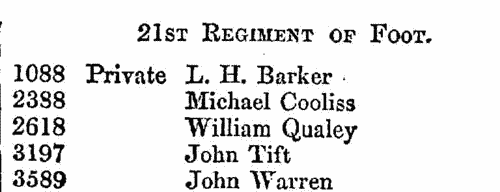Add this eBook to your basket to receive access to all 146 records. Our indexes include entries for the spelling brind. In the period you have requested, we have the following 146 records (displaying 61 to 70): These sample scans are from the original record. You will get scans of the full pages or articles where the surname you searched for has been found. Your web browser may prevent the sample windows from opening; in this case please change your browser settings to allow pop-up windows from this site. Railway Subscription Contracts
(1845)
£21,386,703 6s 4d was promised by about 10,000 subscribers of less than £2,000 per contract to the nearly 200 railway bills deposited in the Private Bill Office during the Session of Parliament for 1845. This alphabetical list gives the full names of the subscribers (surname first), description (i. e., occupation), place of abode, a numerical reference to the title of the railway, the amount subscribed to each, and total. There is a separate key to the titles of the railways. | Sample scan, click to enlarge

| The Edinburgh Gazette
(1846)
The Edinburgh Gazette is the official publication in which various Scottish legal notices are issued, as well as promotions and casualty lists for the British army as a whole, and brief lists of English bankrupts. The key source for tracing details of Scottish bankruptcies, insolvencies, and dissolutions of business partnerships. | Sample scan, click to enlarge

| British Army officers in the annexation of the Punjab
(1845-1849)
By 1845 the Sikh state of Lahore was the remaining substantial military power in the Indian sub-continent outside British rule. Its khalsa army was well equipped, disciplined, tenacious and had three European officers among its commanders. The sikhs controlled not only the Punjab, but Pathan tribes as far as the border with Afghanistan, and the whole of Kashmir. The river Sutlej formed the boundary between the Sikh state and British India. In early December 1845 the Sikh army crossed the Sutlej and invested the British garrisons at Ferozepore; 13 December 1845 the British declared war. After defeat in a series of battles, at Moodkee (18-21 December), Ferozeshah (21-22 December); Budhowal and Aliwal (23 December, 28 January); and Sobraon (10 February 1846), the state of Lahore submitted to the Treaty of Lahore, ceding the Punjab between the Sutlej and the Beas, Kashmir, and paying half a crore of rupees. The state of Lahore itself continued under the durbar as a British protectorate during the minority of the young maharajah; and the Sikh army was put under British command. Kashmir was sold by the British to the ruler of Jammu for a crore, and the submission of Kashmir to Jammu was effected by a Sikh force under British officers. British garrisons were placed in the Punjab, but the fort at Multan refused to submit, and had to be besieged. During the siege a Sikh regiment defected to join other khalsa remnants, in defiance of the durbar at Lahore, and raised a rebellion (August 1848 to January 1849). Battles at Chillianwalla (13 January 1849) and Gujerat (21 February 1849) destroyed the Sikh army. The British then annexed the whole of the Punjab, incorporating it into British India. This account of the Annexation of Punjab by Arthur D. Innes and General Charles Gough was published in 1897, but with a poor index; we have remedied that. The account also includes a description of the battles of Maharajapore and Puniar (29 December 1843) by which the army of Gwalior was destroyed. | Sample scan, click to enlarge

| Assignments of bankrupts' estates in England and Wales
(1851)
Perry's Bankrupt and Insolvent Gazette, issued monthly, included lists of assignments of bankrupts' estates. Each entry gives the name of the bankrupt (surname first, in capitals), the date (in brackets), address and trade; followed by the names and addresses of the trustees to whom the estate was delivered, and the name and address of the solicitor. This is the index to the names of the bankrupts, from the issues from January to December 1851. | Sample scan, click to enlarge

| Traders and professionals in London
(1851)
The Post Office London Directory for 1851 includes this 'Commercial and Professional Directory', recording about 80,000 individuals. | Sample scan, click to enlarge

| Private Residents in Greenwich, Woolwich &c.
(1852)
W. Archdeacon's Greenwich and Woolwich Directory for 1852 (including Deptford, Blackheath, Lewisham, Charlton, Plumstead, Shooter's Hill, Lee,&c.) has two long alphabetical listings, commercial and private residents.
| Sample scan, click to enlarge

| Traders in Greenwich, Woolwich &c.
(1852)
W. Archdeacon's Greenwich and Woolwich Directory for 1852 (including Deptford, Blackheath, Lewisham, Charlton, Plumstead, Shooter's Hill, Lee,&c.) has two long alphabetical listings, commercial and private residents.
| Sample scan, click to enlarge

| British Army Officers
(1853)
The 14th volume of the New Annual Army List, for 1853, corrected to 30 December 1852, was published by Major H. G. Hart of the 49th Regiment. It contained 'the dates of commissions, and a statement of the war services and wounds of nearly every officer in the Army, Ordnance and Marines'. The first section, pages 1 to 111, lists officers of the rank of major and above in order of rank and precedence; officers with local rank (112-114); Yeomen of the Guard (115); the Honourable Corps of Gentlemen-at-Arms (116); Headquarters Staff (117); and then (as in the scan) all the regiments and units in order of precedence, giving any regimental honours, with all the officers by rank, and details of postings, facings and agents (118-336). A long section (337-426) then lists officers on the retired full pay and half-pay, including the Royal Regiment of Artillery, Corps of Royal Engineers, Royal Marines and military departments. Then there are lists of officers in the Commissariat Department, the Medical Department, Veterinary Surgeons and the Chaplains Department. A section of Officers on the Foreign Half-Pay gives lists for the German Legion and Miscellaneous Corps (Brunswick Cavalry, Brunswick Infantry, Chasseurs Britanniques, Royal Corsican Rangers, Dillon's Regiment, Greek Light Infantry, Royal Malta Regiment, Meuron's Regiment, Roll's Regiment, Sicilian Regiment, Watteville's Regiment, York Light Infantry Volunteers, the Foreign Veteran Battalion, and the Foreign Corps of Waggoners). After lists of officers in garrisons and military establishments, there are sections listing officers holding Gold Decorations for their parts in various important actions and other British decorations, and those holding medals bestowed by foreign powers. | Sample scan, click to enlarge

| British soldiers wounded at Inkerman
(1854)
Sebastopol in the Crimea was the great Russian naval arsenal on the Black Sea. A combined assault by British, French and Turkish troops resulted in the reduction of Sebastopol and led to the Treaty of Paris of 27 April 1856, guaranteeing the independence of the Ottoman Empire. In the battle of Inkerman, of November 1854, the Russian troops made an ultimately unsuccessful attack on the allied army. In December the War Office issued lists of soldiers killed and wounded at Inkerman: there are separate returns for 2 to 6 November, 7 to 20 November, and 21 to 26 November, as well as one for soldiers missing, and one for members of the Naval Brigade killed and wounded. This is the list of British soldiers wounded at Inkerman 2 to 6 November 1854. | Sample scan, click to enlarge

| Bankrupts' Assignments
(1855)
Assignments of bankrupts' estates (usually to principal creditors and/or close relatives of the bankrupt) in England and Wales | Sample scan, click to enlarge

|
Research your ancestry, family history, genealogy and one-name study by direct access to original records and archives indexed by surname.
|











